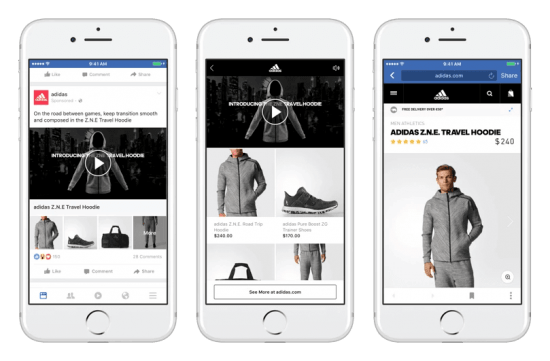Seasonal
Strategy
Why Advertisers Love Collection Ads
Dec 13, 2019
Strategy
Dec 13, 2019
With the busy Christmas period and the second half of the holiday season fast approaching, customers have already started to loosen their purse strings. Whilst many get ready to face the cold temperatures and hit the high streets for their shopping sprees, others prefer to shop from the comfort of their home. Though many turn to their laptops, PCs or tablets for their home shopping, the number of mobile device shoppers has been steadily increasing in the past few years. Smartphones have not only changed the way we behave and connect with people, but also the way we shop. The question here, though, is which ad format advertisers can use to best reach their audiences through their mobile devices. We examine the impact that collection ads have had on advertisers and shoppers alike.
A Collection Ad is an ad format that typically includes either a cover image or video, followed by four product images underneath it. The product images are a part of the product catalogue that an advertiser uploads to Facebook or Instagram, appearing on users’ newsfeed.
With regards to cover content, videos are most commonly used, since nowadays, people are watching more videos on their mobile than ever before, and they like seeing the products in action before deciding to make any purchasing decision.
Once someone clicks on a collection ad, they’ll be directed to an Instant Experience, which is a full-screen experience that drives engagement and can help in generating interest and intent. This highly interactive ad format was formerly known as the ‘Canvas ad’ before Facebook decided to change its name as well as add to its range of capabilities. Instant Experience ads now impressively load 15 times faster than standard mobile websites, allowing brands and businesses to seamlessly connect with their users.

Once users have tapped on an ad, customers will be able to comfortably browse for more products in the catalogue or find out more about the features of a specific product. Facebook said this about their feature: “Facebook Instant Experience ads load instantly, they’re mobile-optimised and designed to capture the complete attention of your audience. Within an Instant Experience, people can watch engaging videos and photos, swipe through carousels, tilt to pan and explore lifestyle images with tagged products – all in a single ad.”
This fast-loading feature enables advertisers to offer viewers an immersive, interactive ad format, which is hosted completely on Facebook, meaning customers can look at and engage with the mobile content without having to leave the app and go on to the seller’s website. However, should they be interested in doing so, they could proceed on to the external website in order to complete a purchase.
Now you might be thinking: Well, we already have the Carousel Ad format, which allows me to look at either several products or various features of a single product within a single ad unit. Think again. What’s lacking here is a form of storytelling, an experience that adds value to the whole journey. And whilst other may suggest that Instant Experience ads on their own could also do the trick, they don’t highlight specific products for customers to purchase.
That’s why, both of the aforementioned issues can be resolved with the help of Collection Ads, by integrating the two experiences with each other, offering you the best of both worlds, and an incisive, visually engaging and highly informative journey for the customer.
The main component of a Collection Ad is the product catalogue, as without it, you have nothing to show your customers. In terms of developing the catalogue, there are two different ways of approaching this.
Collection Ads can help you achieve some of the goals you have set for your business social strategy. Facebook have outlined their 4 goals and objectives for Collection Ads, which come with different Instant Experience templates. They are as follows:
This is what Avery Baker, Chief Brand Officer at Tommy Hilfiger, said about the Collection Ad format:
"We took our video assets to the next level, through integrating shopping functionality. Collection creates a consumer experience that reflects how current generations of digital natives interact with their favourite brands. The results exceeded expectations, generating an ROI increase of over 200%."
With potential results like that in mind, let’s think of some of the best practices that we haven’t mentioned yet. Definitely keep these in mind if you’re thinking of developing collection ads!
Now that you know everything you need to know about Collection Ads, we would love to hear about your experiences and thoughts on this ad format. Is your company using this for their social strategy? Why (not)? Let us know in the comments section below! And before you go, if you have you signed up with The Next Ad yet? There is no better time to do so than now! Enjoy a free two week trial with no strings attached by signing up below!